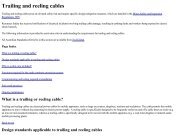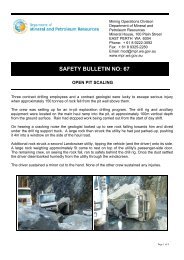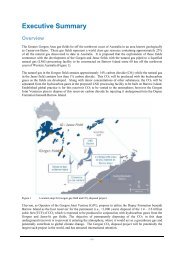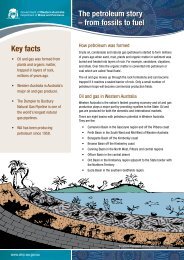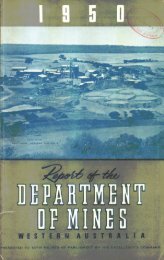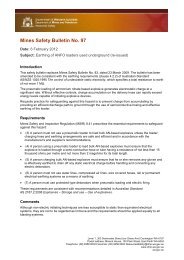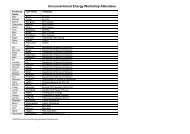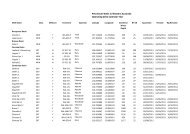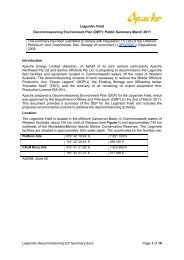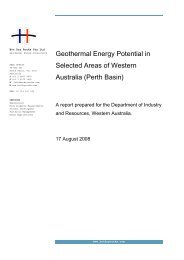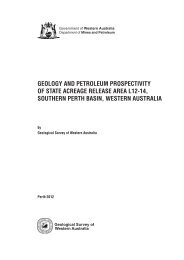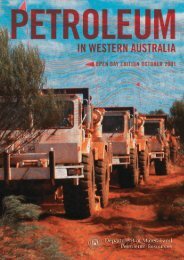MSB No. 105 Under-design of bridge and gantry crane ... - wa.gov.au
MSB No. 105 Under-design of bridge and gantry crane ... - wa.gov.au
MSB No. 105 Under-design of bridge and gantry crane ... - wa.gov.au
Create successful ePaper yourself
Turn your PDF publications into a flip-book with our unique Google optimized e-Paper software.
Mines Safety Bulletin <strong>No</strong>. <strong>105</strong><br />
Subject: <strong>Under</strong>-<strong>design</strong> <strong>of</strong> <strong>bridge</strong> <strong>and</strong> <strong>gantry</strong> <strong>crane</strong> end connections<br />
Date: 2 July 2013<br />
Background<br />
Various types <strong>of</strong> <strong>crane</strong>s are used on mine sites to lift <strong>and</strong> move loads, commonly plant<br />
requiring maintenance during a shut down. This bulletin relates to purpose <strong>design</strong>ed <strong>and</strong> built<br />
<strong>crane</strong>s, including <strong>bridge</strong> <strong>and</strong> <strong>gantry</strong> <strong>crane</strong>s. These <strong>crane</strong>s utilise <strong>bridge</strong> beams, which distribute<br />
the crab loads to the end carriages or support legs (Figure 1).<br />
In the process <strong>of</strong> registering <strong>crane</strong>s on mine sites, Resources Safety has established that many<br />
<strong>design</strong>s do not accommodate all load effects on the end connection <strong>of</strong> the <strong>bridge</strong> beams. In an<br />
attempt to address this <strong>design</strong> deficiency, <strong>crane</strong> owners are exchanging <strong>crane</strong> end connection<br />
bolts as required by the <strong>design</strong>ers for higher class (i.e. stronger) items, but this solution may<br />
not be adequate.<br />
Figure 1 Typical layout <strong>of</strong> a double <strong>bridge</strong> <strong>crane</strong>, with schematic sections showing a bolted end<br />
connection (adapted from image at www.podem<strong>crane</strong>.com/?p=15&l=2&id=3)<br />
Summary <strong>of</strong> hazard<br />
Investigations into a number <strong>of</strong> <strong>crane</strong>s have found the strength <strong>of</strong> some <strong>bridge</strong> beam to end<br />
carriage connections to be inadequate. When the loaded crab moves along its rails, these<br />
connections experience torsion loads that were not considered in the <strong>design</strong> checks. This<br />
torsion load exists bec<strong>au</strong>se the crab wheels apply loads eccentrically on many <strong>bridge</strong> beams.<br />
With the torsion loads added, the end connection bolts experience combined forces that<br />
exceed the limits in the Australian St<strong>and</strong>ards.<br />
Level 1, 303 Sevenoaks Street (cnr Grose Ave) Cannington WA 6107<br />
Postal address: Mineral House, 100 Plain Street, East Perth WA 6004<br />
Telephone: (08) 9358 8002 Facsimile: (08) 9358 8000 ResourcesSafety@dmp.<strong>wa</strong>.<strong>gov</strong>.<strong>au</strong><br />
www.dmp.<strong>wa</strong>.<strong>gov</strong>.<strong>au</strong><br />
<strong>wa</strong>.<strong>gov</strong>.<strong>au</strong>
In these cases, the bolted end connections <strong>of</strong> the double <strong>bridge</strong> <strong>crane</strong> require review <strong>and</strong><br />
possible strengthening due to the <strong>design</strong> oversight. Without this strengthening, there is the<br />
potential for the end connections to fail suddenly, resulting in a collapse.<br />
All <strong>crane</strong>s with eccentrically loaded <strong>bridge</strong> beams <strong>and</strong> end connections with bolts in shear may<br />
be at risk.<br />
Contributory factors<br />
• Analysis <strong>of</strong> the <strong>crane</strong> structure <strong>design</strong>s being investigated indicates that computer<br />
modelling <strong>wa</strong>s simplistic (Figure 2), <strong>and</strong> there <strong>wa</strong>s no modelling <strong>of</strong> the eccentric loading <strong>of</strong><br />
the trolley wheels relative to the centreline <strong>of</strong> the <strong>bridge</strong> beams (Figure 3).<br />
Figure 2 Schematic diagram showing<br />
simplistic modelling for <strong>bridge</strong> beams<br />
whereby simple model loads (blue arrows)<br />
are applied to the <strong>bridge</strong> beam centreline.<br />
Figure 3 Schematic cross section <strong>of</strong><br />
<strong>bridge</strong> beam end connection<br />
showing eccentricity resulting from<br />
loading <strong>of</strong> the crab wheel (red<br />
arrow) relative to that for a load at<br />
the <strong>bridge</strong> beam centreline (blue<br />
arrow).<br />
Mines Safety Bulletin <strong>No</strong>. <strong>105</strong> Page 2 <strong>of</strong> 4
• Rather than including eccentricity in the analysis model, it is possible to manually add a<br />
secondary effect to the calculations. However, this approach can be vulnerable to mistakes<br />
bec<strong>au</strong>se it can be difficult to manage all secondary effects <strong>and</strong> combinations in complex<br />
structures.<br />
• The omission <strong>of</strong> modelling or calculations accounting for eccentric loading <strong>wa</strong>s <strong>of</strong>ten not<br />
identified by the verifier <strong>of</strong> the <strong>design</strong>er’s calculations.<br />
Recommendations<br />
Mine management <strong>and</strong> <strong>crane</strong> owners<br />
• Registered Managers should establish if any <strong>crane</strong>s on their sites have eccentrically<br />
loaded <strong>bridge</strong> beams with the potential end connection defect. If so, management should<br />
establish from the original equipment manufacturer (OEM) whether the <strong>design</strong> omission or<br />
error exists in the <strong>crane</strong>.<br />
• If the <strong>design</strong> omission or error exists, consider an interim short-term operational downrating.<br />
For example, operate the <strong>crane</strong> in a 75 per cent down-rated load-carrying capacity<br />
<strong>and</strong> limit the crab movement to the central third <strong>of</strong> the <strong>bridge</strong> (Figure 4) until the defect is<br />
adequately addressed. These load <strong>and</strong> movement restrictions will produce less force on<br />
the bolted end connections than that experienced during load testing.<br />
Figure 4 Schematic side view <strong>of</strong> <strong>bridge</strong> <strong>crane</strong> showing recommended short-term operating<br />
parameters when eccentricity has not been considered in the <strong>design</strong>.<br />
• Manage the associated risks <strong>of</strong> using the down-rated <strong>crane</strong> through a combination <strong>of</strong><br />
management systems such as the classified plant register, notices, risk assessments,<br />
verification <strong>of</strong> competency (VOC) programs <strong>and</strong> high risk work (HRW) protocols.<br />
• A competent person should inspect the end connections without delay <strong>and</strong> arrange for<br />
them to be strengthened if required.<br />
Mines Safety Bulletin <strong>No</strong>. <strong>105</strong> Page 3 <strong>of</strong> 4
• Ensure all required strengthening is carried out, inspected by a competent person <strong>and</strong><br />
recorded in the relevant plant registers.<br />
• Be a<strong>wa</strong>re that if s<strong>wa</strong>pping out class 8.8 bolts with class 10.9 or higher class bolts, the<br />
higher class bolts can experience stress corrosion cracking (SCC) <strong>and</strong> hydrogen<br />
embrittlement (HE) failures. These failures occur most <strong>of</strong>ten where the bolts are subjected<br />
to tri-axial (or combined) stresses, as is the case with the end connections on the <strong>bridge</strong><br />
beams, <strong>and</strong> the bolts have not undergone specialised manufacturing processes to counter<br />
this.<br />
Designers <strong>and</strong> verifiers<br />
• Crane <strong>design</strong>ers <strong>and</strong> <strong>crane</strong> <strong>design</strong> verifiers must ensure compliance with relevant cl<strong>au</strong>ses<br />
in Australian St<strong>and</strong>ards <strong>and</strong> use sound engineering practice. The analysis <strong>and</strong> <strong>design</strong><br />
process must consider all possible load combinations, primary <strong>and</strong> secondary load effects,<br />
<strong>and</strong> the maximum combined cases.<br />
• Crane <strong>design</strong>ers should consider adopting analysis models that account for all<br />
eccentricities, <strong>and</strong> accurately model end connections to avoid missing secondary effects.<br />
Additional information<br />
Australian St<strong>and</strong>ards, available at www.saiglobal.com<br />
• AS 1418 Cranes, hoists <strong>and</strong> winches – General requirements<br />
• AS 3990 Mechanical equipment – Steelwork<br />
• AS 4100 Steel structures<br />
Simon Ridge<br />
STATE MINING ENGINEER<br />
Mines Safety Bulletin <strong>No</strong>. <strong>105</strong> Page 4 <strong>of</strong> 4



